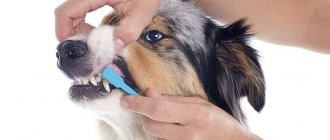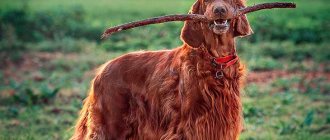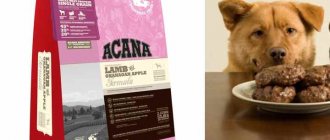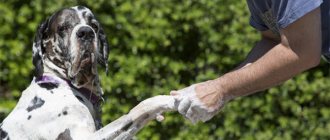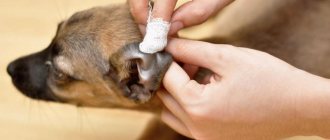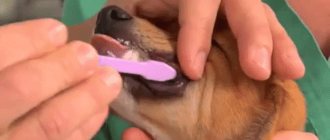Breeders have mixed feelings about toothpaste. Many believe that this is normal pampering and the pet cleans its teeth on its own using bones and hard snacks. Despite natural processes, using even the most ordinary toothpaste will protect your beloved dog from a huge number of diseases.
To fully answer whether toothpaste is needed or not, it is worth understanding this in detail.
What does daily oral hygiene do?
If you visit a veterinarian, then the doctor has probably already told you that there is toothpaste for dogs. It gets rid of the resulting unpleasant odor. This happens by destroying harmful bacteria. Thus, the product can be used for preventive purposes. Regular sanitation of the oral cavity will significantly reduce the risk of developing caries and plaque.
Toothpaste for dogs allows you to quickly and effectively remove food particles that are stuck between the teeth. However, it should be remembered that human compositions cannot be used for a four-legged friend under any circumstances. Even baby toothpaste often contains fluoride, which causes severe poisoning, convulsions, and tremors. And it is unlikely that you will be able to avoid swallowing the composition, especially if you have never performed this procedure before.
Do dogs have their teeth brushed?
Just like humans, dogs develop plaque on their teeth after eating. Dental plaque is an invisible film, a “cocktail” of food debris, bacteria and rejected oral cells. Although this film is not visible, plaque is an excellent tool for the development of caries, damage to tooth enamel by accumulated bacteria.
In the absence of regular dental care, the thin film hardens and turns first into visible plaque, and later into hard tartar.
Plaque on a dog's teeth. Photo: enot.zp.ua
All these processes lead to bad breath, gum damage, toothache and tooth loss. The worst thing is that dirty teeth are a constant source of infection, which can spread to your pet’s internal organs and lead to serious illnesses.
Taking care of your dog's oral cavity by brushing his teeth will help reduce the risk of such problems.
Reasons for the problem
Stone plaques form in hard-to-reach places under unfavorable conditions and lack of hygiene. There are several factors that can cause tartar to appear on a dog’s teeth.
Incorrect selection of feed
The risk of plaque increases significantly if the pet is fed soft food. It does not contribute to prolonged friction of the jaw surfaces and self-cleaning of the teeth. Constantly feeding an animal canned food is the main mistake of modern breeders. It should be remembered that the dog’s teeth need active use. If you stop using the incisors, canines, and molars, the jaw will begin to deteriorate.
Dry food partly solves the problem, since solid particles clean off the initial plaque. But this does not mean at all that dogs consuming “drying” are protected from the formation of tartar.
Impaired metabolism
Excessive carbohydrate content in food leads to a weakening of the body's protective functions. You shouldn’t spoil your furry friend with “tasty food.” Experienced breeders know that sweets are contraindicated for animals - they contribute to the development of diabetes and oral problems. This is due to the accelerated proliferation of bacteria: plaque will appear faster and darken if the dog’s diet is not balanced.
High acidity of saliva
This indicator is individual: everything will depend on the breed, age, gender and other characteristics of the dog’s body. Acidic saliva is a favorable environment for some bacteria; it can become a factor in disrupting salt metabolism. Veterinarians believe that frequent hypothermia and insufficient physical activity can lead to such a deviation.
Late mouth care
Not only people should constantly brush their teeth; pets also need a similar procedure. Even if you feed your dog the highest quality products, over time he will develop deposits in any case. To avoid problems, you should periodically clean the mouth with veterinary paste and give the animal bones specially designed for this.
Irregular teeth structure
Predispositions to the formation of stones include pathological changes in the jaw, malocclusion, narrow interdental spaces, too dense or crooked teeth. All this leads not only to plaque, but also to digestive problems.
Of course, the stone itself does not pose an immediate threat to life. But against the background of enamel damage, diseases can develop, for example, gingivitis, periodontal disease, gastrointestinal disorders, and respiratory problems. And these problems can subsequently lead to the death of the pet.
Untreated tartar weakens the immune system, which inevitably leads to diseases of all kinds. Therefore, caring for a dog’s teeth should be perceived by the owner as an important part of keeping a pet.
Choosing the composition
Today, a veterinary pharmacy will be able to offer you several options. Which one to choose is sometimes difficult to answer right away, so study the composition of the product. Toothpaste for dogs of small breeds, as well as large ones, should be gentle and safe. However, do not forget that each individual component can become a source of allergies. Let's look at the composition of dog pastes, so to speak, in cross-section, so that you can imagine why this or that substance is included in it.
The basis is water. Its function is to dissolve solid residues. This is especially true if your pet eats natural food. Glycerin is used to give the paste a unique texture, viscosity and density. Gum acts as a stabilizer; with its help, the paste maintains its consistency.
To prevent hardening, various substances are used, the safest of which is carrageenan. If it is indicated on the package, you can rest assured about the health of your pet. Usually the paste is sold in the usual white color, this is due to titanium dioxide.
Sorbitol gives the product a pleasant, sweet taste. This is a safe sweetener that does not burden the pancreas and does not cause excess weight gain. To give tooth enamel a flawless shine, abrasive particles are added to the composition, very often this is ordinary baking soda.
How to brush your dog's teeth at home
To maintain your dog's oral hygiene, you can visit veterinary clinics or grooming salons. But if the dog is accustomed to brushing its teeth, then it is not so difficult to do it on its own. At home, the dog will be calmer, and it will be more convenient for the owner to brush his teeth immediately after eating.
Considering that it is advisable to carry out the procedure daily or every other day, going to the clinic or salon with such frequency can become expensive.
Choosing a toothbrush for a dog
Toothbrushes for dogs should be purchased at pet stores and veterinary pharmacies.
The main criteria for choosing a toothbrush are the softness of the bristles and the appropriate size.
Many manufacturers indicate, based on softness and size, what type of breed a given model is suitable for.
Convenient toothbrush for dogs that fits on your finger. Photo: NB's Closet
Brushes for cleaning dog teeth are:
- in the form of a fingertip - soft silicone, put on the owner’s finger, with bristles on one or both sides. Suitable for cleaning the teeth of calm dogs with delicate gums.
- A brush with sponge bristles is suitable for sensitive gums, but does not provide thorough dental hygiene.
- with double bristles and a safety handle: at one end of the long handle there is a large brush, at the other - a small one. This model is suitable for cleaning both large back teeth and smaller front teeth.
- with three bristles: designed for thorough dental hygiene on all sides, suitable for cleaning the teeth of large breed dogs.
- disposable brushes - have soft bristles and are coated with toothpaste. Easy to use - the brushes can be disposed of after use, but the cleaning process becomes somewhat costly.
- treat brushes: both in the form of “bristles” and in the form of seeds.
Which pasta to choose
Toothpaste is essential when brushing; it helps remove plaque, freshen breath, and keep teeth white and healthy.
The main thing in paste is safety, because some part of the paste will inevitably be swallowed by the animal, and this should not harm your pet.
By using special toothpaste for dogs, you don't have to worry if your pet swallows it during the cleaning process.
Different toothbrushes for dogs
Pastes have different tastes and smells: the taste of meat (for example, chicken or beef), with the smell of mint or vanilla.
The main “signs” of a good toothpaste for a dog: thick, white, does not foam, does not require rinsing after brushing the teeth.
Natural plant components, extracts of sage, eucalyptus, tea tree, etc. are added to many pastes. These supplements have a mild healing effect and will be beneficial for the gums.
Toothpaste for dogs from 8in1
Popular brands of toothpaste manufacturers:
- Api-san (Russia),
- Beaphar (Netherlands),
- Hartz (USA),
- 8 in 1 (USA),
- Gimpet (Germany),
- Trixie (Germany),
- Camon (Italy).
These brands have been on the market for decades and have established themselves as leaders in specialty pet oral care products.
Choosing a toothpaste is an individual process and should be taken seriously.
Buy pastes only from veterinary stores or pharmacies.
After the first cleaning, you should check the animal for allergic reactions: any itching or redness on the lips, mouth, swelling on the face. If such symptoms appear, the animal should be shown to a veterinarian, and this paste should be discarded.
How else can you brush your dog's teeth?
Sometimes it is not possible to use veterinary brushes and toothpastes to clean teeth. In this case, you can use suitable alternative remedies.
Gauze swab
If you cannot use a dog toothbrush, you can use a gauze swab wrapped around your finger. This option is not suitable for constant use; a bandage will not be able to remove small particles of food between the teeth or reach hard-to-reach places, and this method is also not always safe. But for emergency cases, if you don’t have a toothbrush at hand, the method can be considered suitable.
Toothbrushes and powders for infants
If it is not possible to purchase a special toothbrush, then you can use toothbrushes designed for children over 6 months. Their bristles are soft, and there is also a model in the form of a fingertip.
It is better to use a special toothbrush. Photo: Teeth Cleaning
As a substitute for toothpaste, you can use tooth powder for the youngest children. Carefully study the composition of the powder: it should not contain fragrances and flavoring additives, as well as fluorine. When used, such a powder should not foam. But you shouldn’t abuse it often either.
Other veterinary oral hygiene products
An alternative to brushing and toothpaste is using veterinary gels, lotions and oral hygiene sprays.
Teeth cleaning gels
They are applied to the teeth and gums after meals; there is no need to use a toothbrush.
Teeth cleaning gel from Api-San
Some gels contain the drug metronidazole, which fights germs on the teeth and relieves inflammation of the gums. The gel with this drug is effective for bleeding, redness, increased sensitivity of the gums and oral mucosa.
Dental lotions and sprays
Just like gels, lotions are applied directly to the teeth after eating, and dental sprays for dogs are sprayed into the open mouth.
Liquids and tablets “for cleaning teeth”
These are special additives that are given to the animal with food. And the drug in the form of a tablet is glued to the gums after eating.
Using only these means, it will not be possible to achieve 100% success in the fight against plaque and tartar, as well as bad breath. Unfortunately, all these remedies only mask bad breath and are not able to definitely prevent caries, since they do not fight the cause - food debris on the teeth.
Only mechanical brushing of teeth using toothpastes can remove food debris and visible plaque on teeth.
Gels, lotions or treats can be used if the dog categorically refuses to brush its teeth and such hygiene is the only solution to the problem of dental care.
Treats for cleaning teeth
A good “backup option” is to use treats to clean your teeth. The shape and structure of the treat mechanically helps clean teeth and prevent the early appearance of caries.
Photo: Christopher
Treats are also selected based on the size of the dog.
For the little ones
Today, many people choose decorative dog breeds: Chihuahuas, toy terriers and other kids are very convenient for apartment living. These dogs live quite a long time, about 20 years, but, unfortunately, they are susceptible to diseases of the oral cavity, in particular they suffer from the presence of tartar. To ensure that your pet remains able to eat normally, it is extremely important to start brushing his teeth with special toothpastes from a very young age. Veterinarians say that this procedure should be performed at least once a week, and it is better to reduce the interval to once every three days.
How often should you brush your teeth?
Lack of regular oral cleaning brings a lot of trouble to a person and his smaller brothers. Often, teeth disfigured by stone growths cannot be treated. If they cannot be saved, there is only one way out - removal. And, it would seem, just recently the tooth was at a curable stage of caries, and today all that remains is to get rid of it in order to prevent further rotting of the deeper bones. Perhaps it will still be possible to overcome the old plaque, but this will only have to be done within the walls of a medical institution and under general anesthesia, which will bring additional hassle, waste of time and money.
At the same time, there is often no need to devote time to sanitizing the dog’s mouth. Two or three times throughout the year is enough. This will not cause any pain to the animal, and the need for anesthesia will also disappear by itself. The procedure itself lasts no more than half an hour, therefore, spending such a small amount of time, the owner will be rewarded with sparkling and healthy teeth of his pet.
Anti-tartar toothpaste for dogs
Daily sanitation of the mouth cavity can serve as a prevention, but not a cure for this disease. Therefore, if you see that your pet’s fangs are covered with gray and yellow spots, and there is an unpleasant odor coming from the mouth, go to see a specialist. However, if you carry out this procedure regularly from puppyhood, you can prevent the development of the disease. Sodium hexametaphosphate, which is part of the paste, helps avoid the appearance of tartar. Sodium triphosphate allows you to quickly remove plaque, and essential oils have refreshing properties.
Special components (enzymes) included in the composition kill microbes, which is extremely important if the dog eats natural food (meat, liver). To prevent the pet from protesting against the hygiene procedure, various flavors are added to the product. They are often attractive to the animal because they resemble peanuts, liver or chicken. So you can choose what suits your pet's taste.
Which composition is safe for animals
Humans should not brush their teeth with toothpaste. After all, it cannot be swallowed, and it is impossible to explain this to a dog or cat. And the paste itself is tasteless, it stings the mucous membrane. Neither the cat nor the dog will definitely like it. The animal cannot rinse its mouth with water and spit the composition into the sink. Therefore, this composition is not suitable for a dog or cat. Moreover, such a paste is dangerous for them, because it contains xylitol and lauryl sulfate, which can be hazardous to the health of pets.
Special formulations are being developed for pets. This includes purified water, which dissolves solid particles. Titanium dioxide and sodium triphosphate remove bacterial plaque. Sodium bicarbonate whitens teeth; enzymes dissolve food debris between teeth.
In order for the paste to be stored for several months without losing its properties, preservatives are added to its composition: sodium benzoate and potassium sorbate. Sorbitol makes the product more pleasant to use. It also includes other flavorings: meat, liver, nuts, vanilla, milk, tomatoes.
It is good if the toothpaste contains natural additives, including parsley seeds, lavender, and tea tree oil. Purified clay makes toothpaste softer. It delicately cleanses the enamel of plaque without compromising the integrity of the enamel.
Pathogenesis
Precipitated mineral salts are gradually deposited on the yellowish soft coating. Initially loose, the formations harden and darken. The gums swell, bleed, and hurt. It becomes difficult for the dog to grind food with its teeth. Stomatitis, abscesses occur, teeth fall out or require removal.
From the source of inflammation, pathogenic microflora is introduced into the internal organs, causing diseases of the stomach, intestines and kidneys. In severe situations, sepsis develops, ending in the death of the pet.
Natural supplements
Toothpaste for dogs can be replete with them. Reviews from owners emphasize that the most important thing is that the pet agrees to endure this procedure, so the fewer fillers that irritate the organs of taste and smell, the better. However, they also perform a certain function, promote the healing of microdamage to the mucosa and have an anti-inflammatory effect. Veterinarians say that the best formulation should include natural clay as an abrasive to cleanse plaque. In this case, the enamel is not damaged. A special feature of the composition for cleaning a dog’s teeth is that it does not create foam, and you don’t have to rinse the mouth.
Side effects
There are no contraindications to the use of gel or spray.
In rare cases, allergic reactions may occur during use due to individual intolerance to the components of the product. The gel can sometimes cause gagging. If unpleasant symptoms appear, treatment with the drug should be stopped and the mouth should be rinsed.
Both forms of Zubastic can lead to staining of the enamel. This is not a contraindication for use.
Choosing a brush for dogs
If we have sorted out the toothpaste: you just need to carefully read the composition, and you will definitely get what you need. In pet stores, consultants most often offer “8 in 1” products: Hartz, Beaphar, Trixie. These are well-known and proven brands that are completely safe for dogs even if swallowed. However, dog toothpaste and brush should be chosen together. It is unacceptable to use a human brush: it is too large and does not fit well in the animal’s mouth. The ideal option would be a tool with a triangular head and very soft bristles.
What not to brush your dog's teeth
It is not advisable to use a human toothbrush: it has bristles that are hard on the animal’s gums, and the size is not suitable for every dog.
Our regular toothpastes are also not suitable for dogs. And it's not just the sharp taste and strong smell. Conventional toothpastes contain large amounts of fluoride, which, if swallowed by an animal, causes metabolic disorders and even poisoning of the body.
But baby toothpastes without fluoride cannot be used either. All pastes for humans contain a sweetener, which can cause seizures and heart problems in dogs.
How to use, or Guide to action
If your pet is already an adult and has never brushed his teeth before, then he is unlikely to like it. When asked whether dogs can brush their teeth with toothpaste, veterinarians emphasize two points. First of all, the optimal composition of the paste itself must be selected, and secondly, the pet must be prepared for the procedure so that it is not stressful for him. Therefore, proceed very carefully.
- For the first time, smear the mixture on your pet’s favorite toy so that he gets used to the new taste.
- Now, in a calm environment, apply a small amount of paste to the brush and start cleaning. To do this, just lift the jowls and lightly brush the bristles along the surface of the lateral teeth. It’s better not to touch the front ones (at least not for the first time), because they are too sensitive.
- Don't forget to praise your pet and give him a treat.
- You need to start by brushing several teeth, gradually increasing the area of exposure.
- If your pet flatly refuses such a procedure, there is no need to force him. Let him chew on a synthetic bone.
Additional Tips
It is important to properly accustom your pet to brushing its teeth so that this procedure does not cause negativity in it.
It is much easier to accustom a puppy to something than an already mature dog. Therefore, your dog should be taught to take care of its teeth from a young age.
You should be careful and use alternative methods of caring for your dog's mouth when necessary, such as when playing.
How to teach a dog to brush its teeth
First of all, a dog should not be forced to brush its teeth if it does not like the process.
The dog got used to brushing his teeth (video)
During training, observe the following rules:
- Get your dog used to brushing its teeth gradually. For example, start with once every two weeks and gradually increase the number of procedures to 2 times every 7 days.
- Cleanse at the same time, for example after an evening meal.
- When brushing for the first time, introduce your dog to the brush and paste and let him smell it.
- Always talk to your pet while brushing.
- When the first signs of aggression appear, you should interrupt the procedure and calm the animal.
- Every time after brushing your teeth, be sure to praise your pet, pet him, and give him his favorite toys.
Be careful
Be sure to follow the principle “Do no harm.” Sudden movements will cause pain to the dog, which it may perceive as an attack and begin to defend itself. As a result, your pet may bite you. Of course, this will not be done out of malice, in this case there is no point in scolding the pet, but the procedure should be interrupted.
Therefore, in order to avoid injuring the dog and not being injured yourself, you should be careful and careful.
If your pet refuses to brush its teeth, it is better to postpone the procedure for a while. Don't let your dog get too nervous so that he doesn't show aggression.
Brushing your teeth while playing
It is noteworthy that cleaning can also be done in a playful way. Manufacturers offer a wide selection of different teeth cleaning toys for dogs. They are various “bones”, “dumbbells”, “balls” and even come in the form of different animals.
The peculiarity of these toys is that their surface is corrugated and is capable of removing some plaque and food debris, as well as massaging the gums.
Toy for the prevention of dental problems. Photo: Will Miller
The toys you choose depend on your dog's size and preferences. Some people prefer ball toys, others in the form of animals.
Many dogs love so-called “rope rings” or “ropes” - they are used not only to maintain dental hygiene due to their texture of intertwined threads, but also as a fun game - tug of war between the owner and the pet or several dogs.
But it should be noted that such teeth-cleaning toys are only suitable as an alternative if it is impossible to use a toothbrush and toothpaste, or as an addition to the main type of brushing.
Treatment at a veterinary clinic
Tartar removal in dogs can be done both at home and in a veterinary clinic. The owner himself chooses the most suitable option, based on the degree of neglect of the animal’s condition. In the initial stages, owners can easily cope with plaque on their own. However, if you already see dark and hard formations, then it is worth visiting an experienced veterinarian who will carry out a high-quality and effective cleaning procedure.
Before removing tartar from a dog, the doctor will carefully examine the pet’s oral cavity, assess the condition of the soft tissues and enamel, and check for inflammation. You are also required to undergo a series of laboratory tests. If the growths are difficult to see, you will have to take an x-ray.
The intervention is carried out under general or local anesthesia, in rare cases - without its use. The latter option is unsafe for an adult who is not accustomed to such procedures - the animal may begin to actively resist. The type of anesthesia for removing tartar in dogs is chosen based on the characteristics of the dog’s nervous system and the level of its education. For dogs with increased excitability and for guard breeds, general anesthesia is used. In this case, the specialist will conduct a detailed examination, and for this purpose additional tests will be prescribed.
Preparation for the intervention occurs as follows: the oral cavity is treated with disinfectants, then the doctor begins to remove tartar from dogs, after which the cleaned area is disinfected. If necessary, the teeth are ground, polished, and fluoridated.
All actions of the veterinarian will depend on the severity of the disease. If the growths are small, then the doctor can use a mechanical method of cleansing. This requires special devices. If the formation is of impressive size, then ultrasound or laser removal is used.
Mechanical removal
Mechanical cleaning involves scraping off plaque using special dental instruments. This option is much cheaper than all the others, but the enamel will become thinner, which will lead to the appearance of new formations. This method can be used only in the initial stages of stone formation and for non-conflict dogs under local anesthesia.
Laser cleaning
The procedure is not very common in the country, but it does not require anesthesia. Cleaning occurs as plaque is washed away with water and air layer by layer. Due to the unpopularity of the procedure, the price can be very high.
Ultrasonic cleaning
This is the most popular method for removing serious fossils. In this case, the formation is affected by special waves of an ultrasonic device, while the enamel remains intact. The procedure is performed by a qualified doctor in a hospital setting. Ultrasonic cleaning is recommended to be carried out annually for those dogs that are at risk: these are elderly dogs and animals with dental or digestive problems.
The duration of the procedure will depend on the area of the lesion and the method of cleaning. The cost varies depending on the city, clinic and method of stone removal. Each owner has the right to decide which procedure to use and whether it is worth saving on their pet.
Popular questions
How to clean your dog's teeth from tartar?
Dogs need to brush their teeth from the age of one, but they are accustomed to this procedure from childhood. To do this, the puppy is introduced to the brush. First, they let him smell it, then they begin to brush their teeth, moving it in a circular motion along the gums. The procedure time may initially be a couple of seconds, but then it needs to be gradually increased. You can smear a treat on the brush to create a pleasant association for your puppy and help him get used to brushing his teeth faster.
How much does it cost to remove tartar from a dog?
On average, ultrasonic teeth cleaning will cost about 2,000 rubles. The larger the dog, the more expensive the cost will be. This is related to the amount of anesthesia that will need to be administered to your pet.
The most popular toothpaste for your pet
This is undoubtedly an 8 in 1 dog toothpaste. This is facilitated by the relatively low price (350 rubles per tube, volume 92 g), as well as the optimal composition. Thanks to its unique components, the paste perfectly cleanses your pet’s mouth, teeth and gums, and also destroys all dangerous pathogenic bacteria, removes unpleasant odors and freshens breath.
The composition meets all the requirements of veterinarians; all components are safe for your pet’s body. These are sodium bicarbonate, sorbitol, water, glycerin, sodium hexametaphosphate, keredzhinene, flavor, potassium sorbate, propylparaben. It is recommended that you do the first brushing without a brush; apply the mixture onto your finger and simply rub it over your pet’s teeth and gums.
What to look for when purchasing
When choosing a paste for your dog, pay attention to the following characteristics:
- The composition of the paste and its consistency. It should be homogeneous and free of lumps. If the paste is very liquid, it may have gone bad and cannot be used;
- Manufacturer. If it is a well-known company, then the chances of counterfeiting are minimal. And it can be dangerous for your pet;
- You should not buy products for future use so that they do not remain unopened until the expiration date. You can see it on the packaging. It itself should be intact, and the tube should be tightly closed;
- Toothpaste for dogs and cats should not foam. But it can be of different shapes. This can be a regular paste, gel, or hard tablets that the dog must chew diligently.
Liquid oral hygiene products
Today, the choice of products for caring for your pets has grown so much that you can already abandon traditional cleaning toothpastes. If your pet flatly refuses to brush his teeth, try this option. Dental Fresh easily and effectively cleans teeth and freshens breath, removes plaque and tartar, and protects gums. Liquid toothpaste for dogs allows you to fully automate the teeth cleaning procedure. The owner is required to add 1 teaspoon of the product per 225 ml to the pet's drinking water daily. This procedure will allow you to maintain oral health. The composition includes stabilized chlorine dioxide - 0.1%, water - 99.9%.
Features of storing toothbrushes
The shelf life of a brush for dogs of small and large breeds is about 4–5 months. As a rule, by this time the owner himself notices changes in the condition of the bristles, and in some cases, wear of the handle. In addition, those brushes that were used to clean the animal’s teeth during the period of illness must be replaced. A large number of pathogenic microbes accumulate on the pile, so such brushes should be thrown away.
After the cleaning procedure, the brush should be rinsed with warm water and placed in a dry place. It is strictly forbidden to store dog hygiene items with human ones. It is also not recommended to store brushes in cases. There they remain wet for a long time, which creates ideal conditions for the reproduction and activity of bacteria.
Dental hygiene procedures are considered an important aspect of caring for your furry pet. Therefore, they cannot be neglected even if the animal resists. To make these procedures as comfortable as possible for the dog, you need to be patient and kind words.
Recommended Posts
At what age and how do dogs begin to change teeth?
Review of 8 super premium dog foods
38 best dog breeds for apartments according to reviews from breeders and owners
Review of cat food or how to choose quality food
Top 7 popular hypoallergenic cat breeds
Review of 7 popular premium cat foods
Making your own pasta
In fact, it is not at all necessary to buy an expensive product for cleaning and sanitizing the oral cavity. Making your own toothpaste for dogs is quite simple, and each of you can make it exactly the way your pet will like it.
- The best option, which most dogs accept normally, is a mixture of white clay and spring water. Water-based honey and sage essential oil act as preservatives. You will need approximately 60 g of a mixture of clay and water, a teaspoon of honey and 2 drops of essential oil. You can add 5 drops of propolis. This mass will last in the bathroom for 2-3 weeks, it is sweetish and dogs like it.
- If you need to whiten your teeth and remove plaque, veterinarians recommend using the following composition. Take half a teaspoon of crushed sea salt and two teaspoons of regular soda. Add half a teaspoon of white clay and the same amount of licorice powder. Add to this amount two teaspoons of glycerin and orange or sweet mint essential oil (3-5 drops).
Judging by the reviews, not all dogs like homemade mixtures, so if you are trying to make paste for the first time, do not make too much. In general, the most positive reviews are about liquid toothpaste. Those owners who have come to the decision to take care of the health of their pet’s teeth when he has already grown up, and it is not possible to accustom him to a brush, speak especially well of her. If you are adopting a puppy, then the experience of most owners suggests that it is best to take the “8 in 1” paste and gradually accustom your pet to it.
